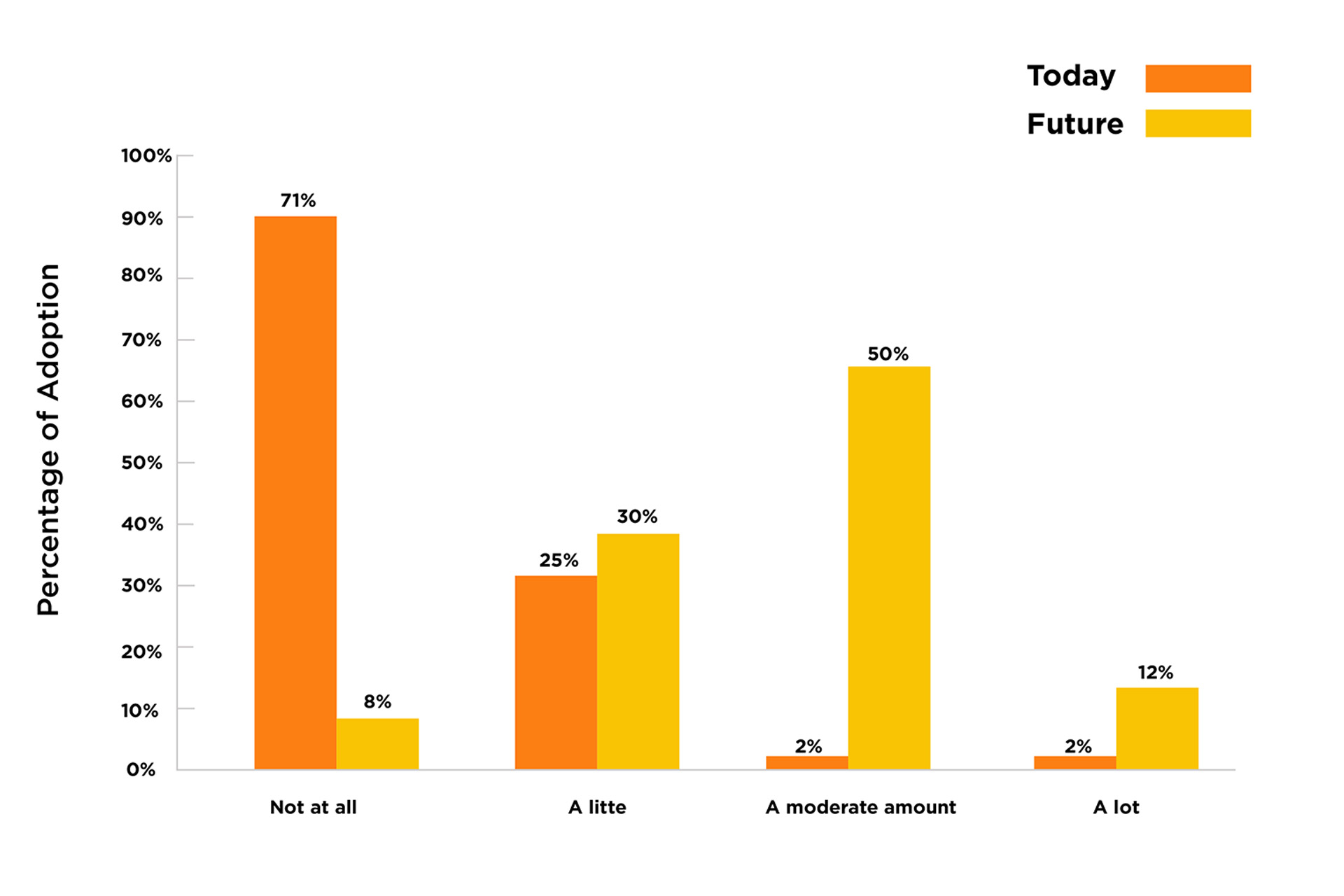
While most businesses don’t use AI in their global mobility programmes today, this is set to change. According to AIRINC’s recent benchmark survey, over 90% of organisations expect to use AI in future, compared to only 30% using it already.
The fastest way to adopt the technology is with open AI like ChatGPT, which pulls information from the internet to answer questions or complete tasks. The results are instant, so even if you need to tweak them, you’ll still save a significant amount of time.
The real benefits, though, come with private AI. This type of AI works with your company’s internal files exclusively, generating insights using data it retrieves from your IT systems, a custom knowledge base, or both.
How much is AI used in your Global Mobility program?

Present applications and future possibilities
Big data analysis

Right now, private AI is mainly used to track and manage expenses, with particular success in spotting inconsistencies. While human oversight remains essential, AI can identify anomalies far faster than manual processes. This data can subsequently inform future analysis.
Beyond financial management, it’s ideal for analysing the rafts of data generated by global mobility operations. From assignee demographics, like age, salary bands and family structure, to the mobility packages offered for different assignment types, AI tools could analyse millions of data points to uncover trends that strengthen decision-making and cut costs.
First-line assignee support and deeper client relationships
AI also has the potential to aid the assignees themselves. Research from CapRelo shows that transferees spend 15 to 30 hours with their relocation consultants and ask an average of 25 to 50 questions throughout their relocation. Using an AI-enabled virtual consultant, both assignees and consultants could save time and resources, with the chatbot able to provide more efficient, on-demand services.
For example, a virtual assistant trained on the employer’s relocation policy and the assignee’s details could help answer questions. It could also provide recommendations tailored to the assignee’s interests and new home, from nearby swimming lessons for the children to local gyms for dad.
With AI automating some of the simpler tasks involved in the relocation process, consultants would have more time and resources to focus on the complex challenges assignees face. Used in this way, the technology would help foster a more personalised relationship and an improved assignee experience.
Potential for human resource divisions
AI analytics could likewise help human resource divisions streamline relocations, even before they are handed over global mobility service providers.
Using the data from previous relocations, talent management could pinpoint which employees are better suited to go on assignment based on various factors, such as their professional responsibilities, their interests, and whether they would benefit from a global placement.
The obstacles to implementation
But incorporating new technology into existing operations is never without teething problems. And in pursuit of the AI promise, early adopters have encountered several challenges.
System readiness

From confirmation emails to scanned documents, assignment data comes in many formats spread across multiple platforms. To an AI tool, however, this data is unusable because it’s not formatted in a way the tool can process. To overcome this, companies may have to completely overhaul how they collect and store data.
At the same time, they must ensure the tool can’t access any sensitive data by thoroughly reviewing user permissions across all files.
This is because private AI assumes the rights of its user. As such, the tool could unintentionally retrieve data from a confidential file if its user’s access isn’t explicitly blocked.
Data quality
Equally inadvertently, employees could jeopardise AI outputs by inputting incomplete or inconsistent data.
For example, if certain offices record housing costs in pounds and others in euros, then an AI tool might misinterpret a €2,000 rent in Germany as £2,000, leading to incorrect cost comparisons or expense forecasts.
Delayed return on investment
A dedicated knowledge database can bypass the problems posed by legacy data but is no silver bullet. Knowledge databases start out empty. They must first be populated by humans, who enter data manually. The AI tool then needs to be trained from scratch on this data, also by humans, before it can fulfil its purpose.
Depending on the functionality required, this process can take up to a year, not only reducing the resources available for other tasks but also delaying the return on investment.
Employee readiness
But the biggest hurdle to AI adoption? For 63% of employers surveyed in the World Economic Forum’s latest Future of Jobs report, the issue is clear: employees lack the skills needed to use AI tools effectively. Pluralsight’s 2024 AI Skills Gap Report supports this, stating that 95% of executives and 94% of IT practitioners believe AI efforts are doomed without proper training.
Non-technical staff must understand the importance of accurate data entry and learn how to incorporate AI into their daily workflows, rather than just offloading repetitive tasks. IT staff need training as well if they are to develop, deploy and maintain AI systems effectively. Pluralsight reports that only 30% have the required skills currently.
The importance of the human connection
Even though overcoming these challenges will demand time and money, global mobility professionals remain enthusiastic about AI’s potential.
Experts agree, however, that the sector’s adoption of the technology will only be successful if relocation teams can balance its power with personal, human connections, and – critically – tailor this balance to each individual assignee. That’s because global mobility, by its nature, demands advisors who can think critically, show empathy, and engage with emotional intelligence – all qualities beyond AI’s capability.
Curious about the other GM trends emerging in 2025? See our trends overview here.














